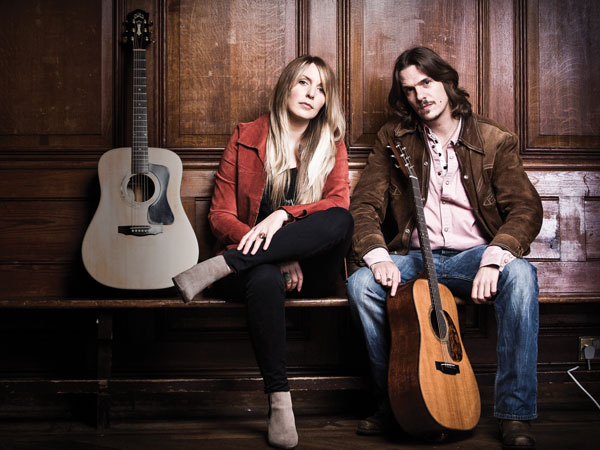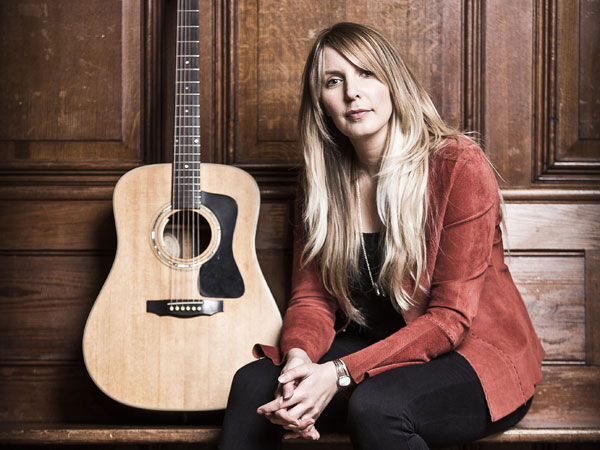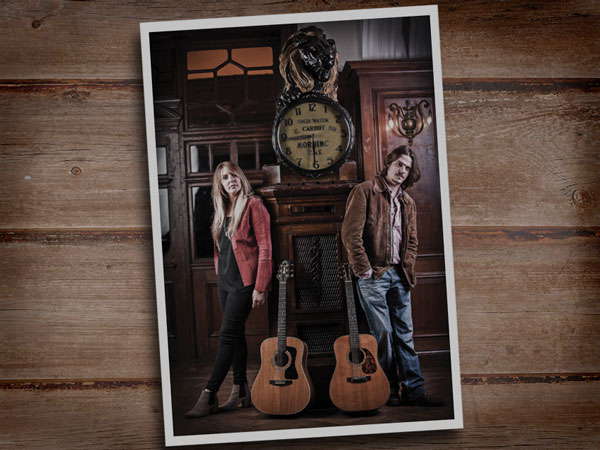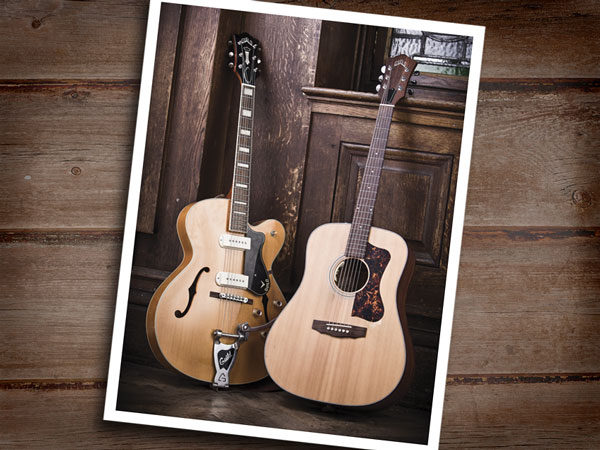Zervas & Pepper talk golden Guilds and new album Abstract Heart
The Welsh duo on their Cardiff via California sound

Introduction
Though rooted in the fertile soil of Californian songcraft, the pristine harmonies and sophisticated arrangements of Zervas & Pepper took leaf in the cooler climes of Wales.
The resulting sound, heard on their much-praised 2012 album, Lifebringer, could be described as CSN with a Celtic edge, though Joni, Jackson Browne and other stellar influences all form part of the blend, too. We caught up with the duo in Cardiff for a chat about tunings, life changes and their compelling new album, Abstract Heart.
After a looping drive around Cardiff in a big old camper van with a flat tyre ("It’s probably been like that for months"), Kathryn Pepper and Paul Zervas park and take us into the Cardiff Coal Exchange, a beautiful and iconic building and another sad example of a venue in very real danger of permanent closure.
"There’s a group called ‘#savethecoalexchange’", says Kathryn, "which is battling to keep it open and get the place sound and running again. It’d be so sad to see it go, it’s been a part of this city for ages".
It’s an important subject for a duo that is proud of where they come from and owe their career to the capital’s acoustic scene, which gets us started on how they formed their sound...
"Paul suggested I do some harmonies. And we were laughing because we knew we just got each other straight away!" - Kathryn Pepper
You guys met at a folk club in Cardiff?
PZ: "It was a live music venue called The Toucan Club and it had all sorts really, from Latin jazz-fusion acoustic music to funk and soul and the rest."
KP: "Some of the nights were real open mic folk club-type jobs, whereas others would have full bands playing all sorts of genres. We were pretty young when we were going there and just wanting to get in with the old guys who were playing greats, so we’d just go to watch their shows; they were all really good musicians."
PZ: "Yeah, it was more the type of place where musicians would go to watch musicians, really, which can be the way with folk clubs. It felt like there was an unspoken standard to get to before you played there, so we would be checking out these guys and it happens that most of them are in our band now! Our guitarist Simon Kingman actually founded the place, it was his club and it ran well for 10 years or so with a good reputation."
How long was it before you two realised there was music between you?
KP: "Immediately. I saw Paul playing at The Toucan, playing his own stuff mixed with songs by Gram Parsons and Neil Young. I was also playing my own songs at the time and we checked each other’s show out and the next time we met Paul suggested I went up with him to do some harmonies. And we were laughing because we knew we just got each other straight away!"
PZ: "It was professional before it was personal, you know?"
KP: "Yeah it was, we were friends and we were writing songs about each other and it just evolved from there, really."

Organic growth
And now you’re three albums in and broaching some pretty big topics together on Abstract Heart; was that a conscious or organic move forward?
PZ: "Organic, I would say."
KP: "Yeah it was a natural shift. With the last album, Lifebringer, life itself was quite heavy at the time; my nan had Alzheimer’s and was dying and a few of our young friends had passed away and we just kind of escaped into Lifebringer and did this whole California thing, which is where our musical heart is, in that whole Laurel Canyon scene. So it was very much an escapist album; everything was quite raw at the time.
"After Lifebringer,we did feel confident that the audience had our backs to some degree" - Paul Zervas
"And then we went to India and it kind of sparked a more introspective and spiritual approach, I suppose, to our songwriting. The first song we wrote from that was Celestial Friend, which was about feeling the presence of our passed friends. From there it was like opening the floodgates and letting in all that had happened in the last few years, and it resulted in a far more introspective set of songs."
PZ: "We got a good deal of attention from Lifebringer, which put us in a place where we could think actually there seem to be a few people out there who are interested in hearing a bit more about us. I mean we didn’t sit down and say ‘Right, let’s spill our guts!’, but we did feel confident that the audience had our backs to some degree."
KP: "When we put that record out initially, the label was worried it was a bit too retro, and they warned us we might get hammered for it, but we just said it was us and it was what we do, and we got a lot of love from the press and the public. It gives you more confidence as an artist to invest in the next one."
Abstract Heart sounds more confident and self-assured. Was there a different approach to composing and recording it?
PZ: "It was slightly different in the sense that we tracked most of the album live at the start in a studio in mid-Wales called Giant Wafer; so the crux of the tracks are live at a base level, and we did a bit of recording in LA. But other than that it was very similar in that most of the guitars vocals and over- dubs were recorded at home by us."
KP: "I think the songwriting was different; on Lifebringer about a third of the songs were properly co-written and on Abstract Heart, the whole thing was co-written, so that is the main difference compositionally, and again it’s that progression within ourselves and the trust in each other that’s coming out stronger. When we started out it was very separate with regards to song writing and it’s developed now to the bulk of our stuff being written equally. And to write very personal songs together, you need that trust, and that’s what has built."
PZ: "It was easier for us to collaborate on things that we’ve experienced together first-hand, rather than Kath trying to come in lyrically on one of my fantasy or fiction pieces, and the same with me on her songs. Because we’ve had that experience together we both have a good sense of what is going on and of what should come next."

Dynamic in the duo
Live you tend to play either as a duo or full six-piece band; how different is the dynamic between the two?
KP: "It’s very different; the two-piece thing is very much like a troubadour venue, 60s drop-tuning relaxed-chatting-to-the- audience type vibe, with lots of interaction with the crowd and taking our time with re-tuning and introducing songs. We also tend to play our more evocative, spacious pieces that need that quieter environment to unfold in."
"There’s more restraint with electric, it’s about what you don’t play; I can thrash my acoustic on stage!" - Kathryn Pepper
PZ: "We’ll strip the tracks back and mess about with some of the livelier ones on record and slow them down and harmonise them more; the harmony work is certainly a bit more intricate in the intimate settings and a bit closer. When we do the full band set up we tend to sing everything really high and really hard."
Is one more difficult than the other?
PZ: "I think that it gets a bit harder with the full band."
KP: "There definitely feels like there is more freedom with the duo and you’re more laid bare, but we don’t mind that, we’re good at that because we’ve done it for so long. With the band it takes more energy; it’s louder and harder and it’s a bigger show. We have to sing at the top of our range, so it’s a bit more of a challenge in that respect."
PZ: "Only within the last year have I been playing electric in the shows as well; I used to only be acoustic and Simon would do the electric work, so it’s been a learning curve in the band shows and I’ve found that more difficult. There’s more restraint with electric, it’s about what you don’t play; I can thrash my acoustic on stage!"
KP: "And the response from the audience is a lot more raucous at the band shows than the genteel folk club vibe of the duo gigs."
PZ: "Yeah, if we play with a band we definitely prefer a standing audience; we noticed that on tour with Deacon Blue; the standing shows were far more enjoyable. On the other hand, with the acoustic duo gigs we much prefer the audience to be seated so we can keep the volume lower and create that intimacy and warmth that you get from the acoustic sound."
On Abstract Heart it sounds like most of the songs took form on acoustic guitar. Do you always write that way?
KP: "All of the songs begin life as acoustic guitar lines; that’s the bedrock of our sound and when playing live or recording everybody involved pitches and pulls from Paul’s guitar. When we do our monitor checks and all of that, it’s Paul’s guitar that needs to be heard first and foremost, because that’s where the root of all the chords are and that’s where the whole core of the sound comes from."
PZ: "All that would have applied to the new recording as well. Sometimes with certain songs we think maybe we’ll try and just take the acoustic away or turn it down and have a bit more breathing space, because our songs tend to be quite full productions. But in the mixing stage or before, we find that the guitar creeps back up or back in and in the end it goes back to where it was before. Basically, we can’t keep the thing away even if we wanted to!
"If you listen to contemporaries now like Jonathan Wilson and Father John Misty and the like, that’s an idea of the kind of sound we are after; a lot of nice vintage sounds like Rhodes and vintage valve guitars, but, at the crux of it and at the heart of it, it’s that acoustic guitar sound."

Celestial slides
And you brought a bit of Indian slide guitar into Celestial Friend...
KP: "That one came together well; Matt Malley, the guy who plays the Indian instruments, is schooled in the ragas and the tunings and what they mean. In Indian music, chord progressions mean something, so you’ll have a raga for the morning, or you’ll have a raga for the evening; all of these different chord progressions in different timings mean different things and it’s a very spiritual thing."
"A common tuning we’ve always used on our records is standard except the B string is down to A and the high E string is down to D" - Paul Zervas
PZ: "So, when we played Celestial Friend to Matt, he said, ‘Oh, that’s interesting, because the raga that you’re playing in the last part of that song means ‘birth life and life after death’.’ And we thought about how well that fitted with the subject matter, as the song itself is about two friends who passed away and Matt didn’t know that beforehand. That was pretty out there!"
KP: "We’ve been so lucky with the players on the album; Matt is great and Marcus Eaton, who played on Miller, is just amazing. And keep an eye out for Robbie McIntosh too, he’s a fantastic musician."
Which tunings did you use on the record?
PZ: "Well, Here And Now has the Nashville setup, which is usually standard, but up an octave, so it’s the high strings of a 12-string guitar, basically. On that song it’s standard Nashville except for the bottom A and the bottom E; I dropped the bottom A to G and the bottom E to C; that’s a lovely one to try.
"A common one we’ve always used on our records is standard except the B string is down to A and the high E string is down to D; that one features on probably about five or six of our songs over this record and Lifebringer. Songs like Buffalo Crow from the second album and Foolish Dreamer from Abstract Heart were in that tuning. So that’s common; DADFAD, also, that’s used a fair bit. God, there have been a fair few, I’m struggling to get all of them, but those are the main ones, I would say."
KP: "It’s so good using those open tunings, because it also opens your vocal register up; it’s a bit like on piano, there’s not really anywhere you can’t go."
PZ: "You get sweeter chord voicings from those type of tunings and it certainly helps when we’re playing the small acoustic gigs, with just two voices and one guitar; you get a fullness and orchestral sound that you may not get from a guitar tuned standard. Of course your type of string is important too; I tend to go to Elixir strings, I find that the coating they use as their selling point works really well when you’re dropping down, and they’re great for longevity and, ahem, slightly moist hands!"

Golden Guilds
Paul Zervas on his guitars of choice...
PZ: "My main guitar is a Guild DV52 dreadnought and it’s one of their upper end models. I only use Guild for the most part; I think it was seeing Richie Havens in Woodstock when he opens the festival with a Guild that kicked it all off - it’s fantastic! The best live moment ever; he’s just thrashing this Guild and that started that obsession.
"It’s actually quite a rare guitar, and it’s really heavy for a dreadnought, too" - Paul Zervas
"Anyway, rosewood back and sides - that’s quite unusual for me, I usually go mahogany for dreadnoughts - ebony board and bridge. It was built in the early 90s, so it’s a Rhode Island Guild, made before Fender got involved. It’s actually quite a rare guitar, this, and it’s really heavy for a dreadnought, too. It’s a workhorse guitar; it can be really loud or quiet and I find it really good for both picking and strumming and it takes low D tunings and multiple tunings really well.
"I also use a Sim Daley Dreadnought, which I’ve had about eight months, and that’s the closest I’ve come yet to a custom build. It’s about five thousand dollars new, but I didn’t pay that for it! It’s beautiful, a lot lighter than the Guild. Sim specialises in mandolins for bluegrass players, but he also builds these pre-war Martin-style Dreads. It’s called an SD-18, but it’s more of a 28 in style, with the adornments and the herringbone and all that. This one is mahogany for the back and sides with an Adirondack spruce top and ebony board and bridge. It’s beautiful for standard- tuned work, so warm with that red spruce."
Zervas & Pepper tour the UK in April. Abstract Heart is available for pre-order from 20 April at zervasandpepper.com.

